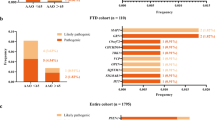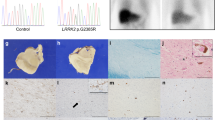Abstract
Thirteen families have been described with an autosomal dominantly inherited dementia named frontotemporal dementia and parkinsonism linked to chromosome 17 (FTDP-17)1,2,3,4,5,6,7,8,9, historically termed Pick's disease10. Most FTDP-17 cases show neuronal and/or glial inclusions that stain positively with antibodies raised against the microtubule-associated protein Tau, although the Tau pathology varies considerably in both its quantity (or severity) and characteristics1,2,3,4,5,6,7,8,12. Previous studies have mapped the FTDP-17 locus to a 2-centimorgan region on chromosome 17q21.11; the tau gene also lies within this region. We have now sequenced tau in FTDP-17 families and identified three missense mutations (G272V, P301L and R406W) and three mutations in the 5′ splice site of exon 10. The splice-site mutations all destabilize a potential stem–loop structure which is probably involved in regulating the alternative splicing of exon10 (ref. 13). This causes more frequent usage of the 5′ splice site and an increased proportion of tau transcripts that include exon 10. The increase in exon 10+ messenger RNA will increase the proportion of Tau containing four microtubule-binding repeats, which is consistent with the neuropathology described in several families with FTDP-17 (refs 12, 14).
This is a preview of subscription content, access via your institution
Access options
Subscribe to this journal
Receive 51 print issues and online access
$199.00 per year
only $3.90 per issue
Buy this article
- Purchase on Springer Link
- Instant access to full article PDF
Prices may be subject to local taxes which are calculated during checkout



Similar content being viewed by others
References
Foster, N. L. et al. Frontotemporal Dementia and Parkinsonism Linked to Chromosome 17: A Consensus Statement. Annu. Neurol. 41, 706–715 (1997).
Wilhelmsen, K. C., Lynch, T., Pavlou, E. & Nygaard, T. G. Localization of disinhibition-dementia-parkinsonism-amyotrophy complex to 17q21-22. Am. J. Hum. Genet. 55, 1159–1165 (1994).
Baker, M. et al. Localization of frontotemporal dementia with parkinsonism in an Australian kindred to chromosome 17q21-22. Annu. Neurol. 42, 794–798 (1997).
Froelich, S. et al. Mapping of a disease locus for familial rapidly progressive frontotemporal dementia to chromosome 17q12-21. Am. J. Med. Genet. 74, 380–385 ( 1997).
Murrell, J. et al. Familial multiple system tauopathy with presenile dementia localized to chromosome 17. Am. J. Hum. Genet. 61, 1131–1138 (1997).
Wijker, M. et al. Localization of the gene for rapidly progressive autosomal dominant parkinsonism and dementia with pallido-ponto-nigral degeneration to chromosome 17q21. Hum. Mol. Genet. 5, 151– 154 (1996).
Heutink, P. et al. Hereditary fronto-temporal dementia is linked to chromosome 17q21-22. A genetic and clinico-pathological study of three Dutch families. Annu. Neurol. 41, 150– 159 (1997).
Yamaoka, L. H. et al . Linkage of frontotemporal dementia to chromosome 17- clinical and neuropathological characterization of phenotype. Am. J. Hum. Genet. 59, 1306–1312 ( 1996).
Dark, F. Afamily with autosomal dominant, non-Alzheimer's presenile dementia. Austr. N. Z. J. Psychiat. 31, 139–144 (1997).
Constantinidis, J., Richard, J. & Tissot, R. Pick's disease: Histological and clinical classification. Eur. Neurol. 11, 208–217 (1974).
Andreadis, A., Brown, W. M. & Kosik, K. S. Structure and novel exons of the human tau gene. Biochemistry 31, 10626– 10633 (1992).
Spillantini, M. G., Bird, T. D. & Ghetti, B. Frontotemporal dementia and parkinsonism linked to chromosome 17: A new group of tauopathies. Brain Path. 8, 387–402 (1998).
Goedert, M., Spillantini, M. G., Potier, M. C., Ulrich, J. & Crowther, R. A. Cloning and sequencing of the cDNA encoding an isoform of microtubule-associated protein tau containing four tandem repeats: differential expression of tau protein mRNAs in human brain. EMBO J. 8, 393–399 (1989).
Spillantini, M. G. et al. Familial multiple system tauopathy with presenile dementia: a disease with abundant neuronal and glial tau filaments. Proc. Natl Acad. Sci. USA 94, 4113– 4118 (1997).
Goedert, M. et al. Assembly of microtuble-associated protein tau into Alzheimer-like filaments induced by sulphated glycosaminoglycans. Nature 383, 550–553 (1996).
Goedert, M., Spillantini, M. G., Jakes, R., Rutherford, D. & Crowther, R. A. Multiple isoforms of human microtuble-associated protein tau: sequence and localization in neurofibrillary tangles of Alzheimer's disease. Neuron 3, 519– 526 (1989).
The Lund and Manchester groups. Clinical and neuropathological criteria for frontotemporal dementia. J. Neurol. Neurosurg. Psychiat. 57, 416– 418 (1994).
Butner, K. A. Kirschner, M. W. J. Tau protein binds to microtubules through a flexible array of distributed weak sites. J. Cell. Biol. 115, 717–730 (1991).
Reed, L. A. et al. Autosomal dominant dementia with widespread neurofibrillary tangles. Annu. Neurol. 42, 564– 572 (1997).
McGeer, P. L., Schwab, C., McGeer, E. G., Haddock, R. L. & Steele, J. C. Familial nature and continuing morbidity of the amyotropic lateral sclerosis-parkinsonism dementia complex of Guam. Neurology 49, 400– 409 (1997).
Goedert, M. Tau protein and the neurofibrillary pathology of Alzheimer's disease. Trends Neurosci. 16, 460–465 (1993).
Church, D. M. et al . Isolation of genes from complex sources of mammalian genomic DNA using exon amplification. Nature Genet 6, 98–105 (1994).
Eperon, L. P., Graham, I. R., Griffiths, A. D. & Eperon, I. C. Effects of RNA secondary structure on alternative splicing of pre-mRNA: is folding limited to a region behind the transcribing RNA polymerase? Cell 54, 393–401 ( 1988).
Kuo, H.-C., Nasim, F.-U. H. & Grabowski, P. J. Control of alternative splicing by the differential binding of U1 small nuclear ribonucleoprotein particle. Science 1251, 1045–1050 ( 1991).
Dickson, D. Neurodegenerative diseases with cytoskeletal pathology: a biochemical classification. Annu. Neurol. 42, 541– 543 (1997).
Conrad, C. et al. Genetic evidence of the involvement of τ in progressive supranuclear palsy. Annu. Neurol. 41, 277 –281 (1997).
Higgins, J. J., Litvan, I., Pho, L. T., Li, W. & Nee, L. E. Progressive supranuclear palsy is in linkage disequilibrium with the τ and not the α-synuclein gene. Neurology 50, 270–273 (1998).
Freier, S. M. et al . Improved free-energy parameters for predictions of RNA duplex stability. Proc. Natl Acad. Sci. USA 83, 9373–9377 (1986).
Acknowledgements
This work was supported by an NINDS (RO1) grant to MH, an NIA (MCSDA) grant to T.L. and NIA (P50) grants to A.G. and J.C.M. and to M.H., J.H. and R.C.P. Additional support was provided by the Mayo Foundation (M.H., J.H.), the International Foundation for Alzheimer Research, the Dutch Brain Research Foundation (P.H.) and Judith Mason (P. Dodd). A.G. is the recipient of an NIH career development award (NIA). C.L.L. was a Washington University Alzheimer's Disease Research Center postdoctoral fellow. P.R. is the recipient of a TMG of EU grant. J.M.K. is the recipient of an NSADA award. T.L. is the recipient of Irving Scholar, NARSAD and Parkins's Disease Foundation awards. We thank the Mayo Clinic Molecular Biology Core Facility for sequencing and acknowledge the support of the Dutch Brain Bank (W.K., R.R.), the Michigan ADRC Brain Bank and the Columbia University Brain Bank. The participation of the families has been crucial.
Author information
Authors and Affiliations
Corresponding authors
Rights and permissions
About this article
Cite this article
Hutton, M., Lendon, C., Rizzu, P. et al. Association of missense and 5′-splice-site mutations in tau with the inherited dementia FTDP-17. Nature 393, 702–705 (1998). https://doi.org/10.1038/31508
Received:
Accepted:
Issue Date:
DOI: https://doi.org/10.1038/31508
This article is cited by
-
Quantitative live cell imaging of a tauopathy model enables the identification of a polypharmacological drug candidate that restores physiological microtubule interaction
Nature Communications (2024)
-
TAF15 amyloid filaments in frontotemporal lobar degeneration
Nature (2024)
-
Cryo-EM structures reveal variant Tau amyloid fibrils between the rTg4510 mouse model and sporadic human tauopathies
Cell Discovery (2024)
-
The advent of Alzheimer treatments will change the trajectory of human aging
Nature Aging (2024)
-
Complexes of tubulin oligomers and tau form a viscoelastic intervening network cross-bridging microtubules into bundles
Nature Communications (2024)
Comments
By submitting a comment you agree to abide by our Terms and Community Guidelines. If you find something abusive or that does not comply with our terms or guidelines please flag it as inappropriate.



